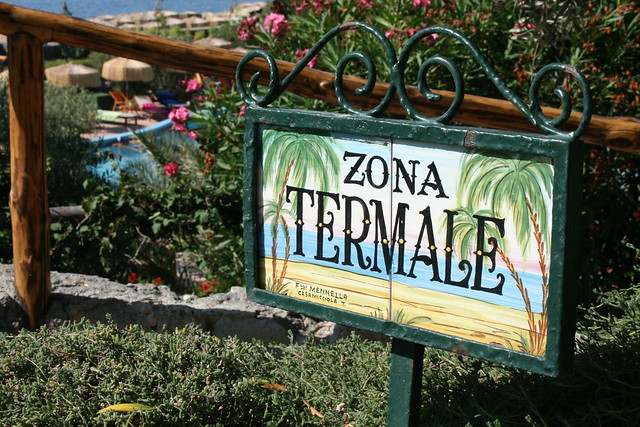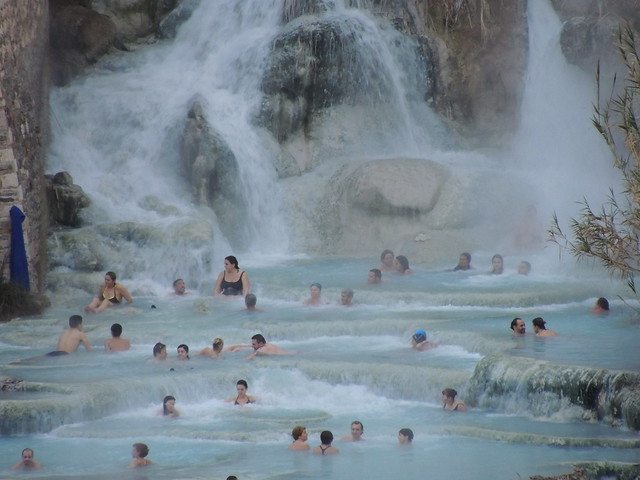Italy, with its healthy work/life balance and cultural propensity for careful grooming, is an excellent place to indulge in a bit of luxurious pampering. You’ll find a variety of spas and spa-like facilities from north to south – with high standards of professionalism and hygiene, and relatively accessible rates – offering anything from the purely relaxing soak in a hot spring to a more pragmatic mani/pedi to counter the wear and tear of an overseas trip.

(Photo by GHT via Flickr)
Here are a few basics to help you navigate Italy’s spas:
Terme (Hot springs)
The most indulgent facilities (and the most historic) in Italy are the many hot springs. Italians have been “taking the waters” since Roman times, and thermal spring spa visits are so much a part of Italian life that the national healthcare system covers annual visits for all Italians. Many spas tout the curative effects of their waters for specific ailments, from the liver to the skin, but most are considered generally beneficial for everything from the respiratory system to muscle aches.

(Photo by Nicolò Lazzati via Flickr)
Though there are a number of natural thermal areas around Italy where you can bathe for free, it’s best to spend a day in a spa facility where there is a full range of services. The entrance fee to a spa includes access to its basic services: changing rooms and showers, lockers for your personal belongings, at least one thermal pool for soaking, a snack bar, and a staff of massage and physical therapists offering massages and treatments that must be reserved ahead of time and paid for separately. You will have to bring your own bathing suit, towel, robe, and flip flops, and you do not need to book ahead of time.
The more luxurious spas offer higher-end basic services, full-service restaurants, a wider range of massages and treatments, more thermal pools, robes and flip-flops, and extensive grounds. Many luxury thermal baths also offer accommodation, so you can book an overnight stay and a multi-day pass into the adjacent spa. Thermal spas are relatively inexpensive in Italy, and even the most luxurious and well-known offer day passes between about €35 and €50 per person.

(Photo by Diana Skok Corridori via Flickr)
Again, thermal baths in Italy are considered therapeutic, so don’t worry about feeling out of place if you don’t have a perfectly toned and tanned physique. You’ll find your fellow bathers to be anywhere from young children there for a day with their families to ward off chest colds to senior citizens there to soothe their aches and pains, and everyone in between. The most famous terme in Italy are concentrated in Tuscany and Ischia, but there are hot springs scattered across the peninsula from Piedmont to Puglia.
Centro benessere (Spa)
If the waters are not thermal, but the services are akin to those of “le terme”, it is called a “centro benessere”, or spa. Commonly adjacent to luxury hotels, a centro benessere will almost always accept clients who are not guests, but you may have to book a spot ahead of time. You will generally have to bring a swim suit, but towels, robes, and flip flops will be included.

(Photo by Giorgio Minguzzi via Flickr)
A basic pass will allow you to soak in the hot tub or pool, and use the sauna, Turkish steam bath, massage showers, hammam, or other amenities. Any special treatments or massages must be reserved and are charged separately; most spas offer package deals with a pass, treatment, and other services included.
The vibe in a centro benessere is more similar to what you might find in a spa in the US: more than therapeutic, these facilities are blissfully indulgent. The clientele is a bit more upscale (and adult) than in most terme, and you’ll find a lot of girlfriends out for the day at the spa, romantic couples, and single clients looking for a little R&R.
Centro estetico (“Beauty shop”)
Though some centri benessere also offer more basic beauty services like manicures and waxes, most Italians go to a “centro estetico” – what might be called a beauty shop – for anything that does not involve water therapies or saunas. You can get facials, manicures and pedicures, waxes, massages, body treatments, and tanning in most centri estetici. The only thing you will NEVER find is hair styling (see below).

(Photo by Cento estetico Camilla Merino via Flickr)
Though some bigger cities have service-specific shops like nail salons, overwhelmingly all beauty services are offered at a more general centro estetico in Italy, and which are the best is a matter of opinion and taste. Your best bet is to ask your hotel or a local for recommendations, though the quality of Italian “estetiste”, or beauticians, is generally excellent. Avoid any “centro massaggio” which are probably – ahem – “massage parlors”. You will almost always have to make an appointment at a centro estetico ahead of time, most are closed on Sundays and Mondays, and you do not have to tip.
Parrucchiere (Hair salon)
Italians, especially women, are very attentive to their hair. The vast majority of women color their hair until a quite advanced age, and many visit the salon weekly for a blow out or touch up. You can hardly walk a block in any Italian city without passing a hair salon, so if you are due for a trim or style, you will have no problem finding what you need.

(Photo by Andrea via Flickr)
As with beauticians, hair stylists are a matter of opinion and taste, so get recommendations from your hotel or a local. Get a feel for the vibe of the salon – some cater to an older, and some to a younger, crowd – and be clear about what you want. Color and cut are generally excellent in Italy; blow outs can be a bit more fussy than what you are used to.
A visit to the hair salon in Italy is notoriously a time-consuming affair, so be sure you don’t have a plane to catch in the next few hours. You will almost always have to make an appointment at a parrucchiere ahead of time, most are closed on Sundays and Mondays, and you do not have to tip.
Related posts:
Italy’s Islands: Ischia
What To Do In Italy When It Rains
La Maremma


